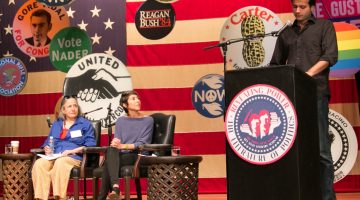Culture Vulture
The ERA: History one apparently never learns at school, Part III
Women won the vote with the ratification by the last required state, Tennessee, on Aug. 26, 1920.
“Equality of rights under the law shall not be denied or abridged by the United States or by any state on account of sex.” This 24-word Equal Rights Amendment (ERA) was approved by Congress, March 22, 1972.
The connection between these two historical events is Alice Paul. Born in July 9, 1885, she was only 25 when the suffrage battle—which at the end she largely led—was won. (The internet reference here is Library of Congress > American Memory.)
The lifelong “activist and reformer was raised as a Quaker, attended Swarthmore College and worked at the New York College Settlement while attending the New York School of Social Work. Alice Paul left for England in 1906 to work in the settlement house movement there for three years. She studied at university in England, and returned to get her Ph.D. from the University of Pennsylvania (1912).”
Unlike her ladylike and sometimes timid foremothers, Paul was an activist through and though. She rose quickly to leadership as “chair of a major committee (congressional) of the National American Woman Suffrage Association (NAWSA) . . . but a year later” after the historic March 3, 1913, suffrage march, “she and others withdrew from the NAWSA to form the Congressional Union for Woman Suffrage. This organization evolved into the National Woman’s Party in 1917, and Alice Paul’s leadership was key to this organization’s founding and future.
“Alice Paul and the National Woman’s Party emphasized working for a federal constitutional amendment for suffrage. Their position was at odds with the position of the NAWSA, headed by Carrie Chapman Catt, which was to work state-by-state as well as at the federal level. Despite the often strong acrimony between the National Woman’s Party and the National American Woman Suffrage Association, it’s probably fair to say (in retrospect) that the two groups’ tactics complemented each other: The NAWSA’s taking more deliberate action to win suffrage in elections meant that more politicians at the federal level had a stake in keeping women voters happy, and the NWP’s militant stands kept the issue at the forefront of the political world.”
After August 1920, both organizations had to decide on future goals. NWP chose immediately to work for an amendment that would truly mean equality under law for women: The ERA. At a NAWSA convention earlier that year, Chapman Catt had founded the League of Women Voters and LWV, on the other hand, felt it more important to educate women to be responsible, intelligent, independent voters. LWV of the United States soon had active chapters throughout the country. Those chapters have survived (sometimes, as in Key West, with a period of inactivity for a number of years and then a renaissance) to the present day.
But the National Woman’s Party survived as well; Alice Paul died in a New Jersey nursing home in 1977 but the last member of the party, living in their headquarters, the Belmont Seward House in Washington, D.C., lived into the 1990s; in 1997, Seward Belmont House became a 501(c) organization. These were the activists. They got ERA introduced into every Congress from 1920 to 1972 and helped convince President John F. Kennedy to found a national Commission on the Status of Women. State, county and even city commissions were then established.
It was at a 1966 convention of the National Association of Commissions on Women (NACW) that, as the story goes, late at night in Betty Friedan’s hotel room, the delegates were disheartened by the slow progress toward equality. “We need a NAACP for women,” someone said. The next morning at breakfast the National Organization for Women was founded. NOW, with the NACW and other, later women’s organizations such as the Women’s Equity Action League and The National Women’s Political Caucus (which took as its ultimate goal to elect more women to Congress), spearheaded the passage of the ERA and the ratification effort. The second wave of the U.S. Women’s movement was born.
But some men in Congress were not giving up that easily. The ERA was passed with a time limit—the only constitutional amendment in the history of the nation to be so limited. Required were 72 percent of the 50 states or 36 states. The feminists won 33 before the extended deadline of June 30, 1982. The ERA failed. However, some legal minds consider the time limit illegal, and thus ratification efforts continue in the unratified states, particularly Illinois and Florida.
TO BE CONTINUED
That’s all for now — gotta fly!
[livemarket market_name="KONK Life LiveMarket" limit=3 category=“” show_signup=0 show_more=0]




No Comment